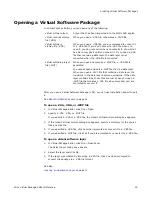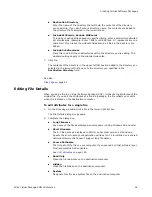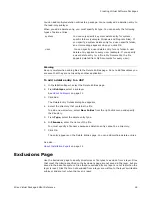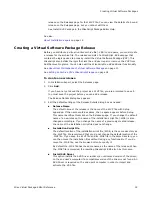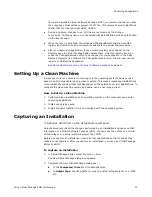
Wise Virtual Package Editor Reference
29
Creating Virtual Software Packages
An end user can reset a layer from Add/Remove Programs by selecting Repair on the
Maintenance Mode dialog box.
See
About User Maintenance of Virtual Software Packages
on page 11.
Example: If your application creates data files, you could create an exclusion for each of
your data file types. When an end user creates and saves application data files, the files
are not redirected to the layer. Instead, those files are saved in the base file system.
To exclude user profile directories from a layer on the end user’s computer, select a
directory in Windows\Profiles.
When you use SetupCapture to capture an application’s installation, any file extensions
that have a file association with that application’s files will appear on the Exclusions page
automatically.
To add exclusions to a Virtual Software Package (VSP)
1. In Installation Expert, select the Exclusions page.
2. Click Add.
The Exclude Details dialog box appears.
3. To specify file extensions:
a. Mark File extension.
b. Enter the file extension.
You can specify only one extension per exclusion. Do not include the period or
wildcard asterisk, as it will be interpreted as part of the file extension (example:
do not use .doc or *.doc).
4. To specify a directory:
a. Mark Directory.
b. Select the directory.
c.
To exclude subdirectories, mark Exclude subdirectories. By default,
subdirectories are not excluded.
5. Click OK.
The exclusion is added to the list of exclusions. You can add multiple exclusions. To
delete or edit an entry, select Delete or Details from its right-click menu.
See also:
About Installation Expert
on page 14
Events Page
Use the Events page to configure command lines or WiseScripts to be executed when
layer events are triggered. This lets you add functionality to your Virtual Software
Package (VSP). You cannot add WiseScripts to a virtual software layer.
Examples: Set configuration options that are user-specific, display an end-user license
agreement, or evaluate the destination computer’s operating system and install .DLL
files specific to that operating system.





